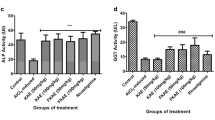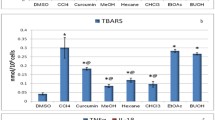Abstract
Aflatoxins are potent hepatotoxic and hepatocarcinogenic agents. Reactive oxygen species and consequent peroxidative damage caused by aflatoxin are considered to be the main mechanisms leading to hepatotoxicity. The present investigation aims at assessing the hepatoprotective effect of ethanolic leaves extract of Trianthema portulacastrum on aflatoxin B1 (AFB1)-induced hepatotoxicity in a rat model. The hepatoprotection of T. portulacastrum is compared with silymarin, a well known standard hepatoprotectant. Lactate dehydrogenase, alkaline phosphatase, alanine and aspartate aminotransferases were found to be significantly increased in the serum and decreased in the liver of AFB1 administered (1 mg/kg bw, orally) rats, suggesting hepatic damage. Marked increase in the lipid peroxide levels and a concomitant decrease in the enzymic (superoxide dismutase, catalase, glutathione peroxidase, glutathione reductase, glucose-6-phosphate dehydrogenase and glutathione-S-transferase) and nonenzymic (reduced glutathione, vitamin C and vitamin E) antioxidants in the hepatic tissue were observed in AFB1 administered rats. Pretreatment with T. portulacastrum (100 mg/kg/p.o) and silymarin (100 mg/kg /p.o) for 7 days reverted the condition to near normal. The results of this study indicate that the ethanolic leaves extract of T. portulacastrum is a potent hepatoprotectant as silymarin.
Similar content being viewed by others
References
Bennett JW, Klich M. Mycotoxins. Clin Microbiol Rev 2003; 16: 497–516.
Fink-Gremmels J. Mycotoxins: their implications for human and animal health. Vet Q 1999; 21: 115–120.
Wogan GN. Aflatoxin as a human carcinogen. Hepatol 1999; 30: 573–575.
Sharma RA, Farmer PB. Biological relevance of adduct detection to the chemoprevention of cancer. Clin Cancer Res 2004; 10: 4901–4912.
Klein PJ, Van Vleet TR, Hall JO, Coulombe Jr RA. Biochemical factors underlying the age-related sensitivity of turkeys to aflatoxin B(1). Comp Biochem Physiol C 2002; 132: 193–201.
Preston RJ, Williams GM. DNA-reactive carcinogens: mode of action and human cancer hazard. Criterion Rev Toxicol 2005; 35: 673–683.
Towner RA, Qian SY, Kadiiska MB, Mason RP. In vivo identification of aflatoxin-induced free radicals in rat bile. Free Rad Biol Med 2003; 35: 1330–1340.
Sohn DH, Kim YC, Oh SH, Park EJ, Li X, Lee BH. Hepatoprotective and free radical scavenging effects of Nelumbo nucifera. Phytomed 2003; 10: 165–169.
Berg D, Youdim MB, Riederer P. Redox imbalance. Cell Tiss Res 2004; 318: 201–213.
Janssen YM, Van Houten B, Borm PJ, Mossman BT. Cell and tissue responses to oxidative damage. Lab Invest 1993; 69: 261–274.
Franschini F, Demartini G, Esposti D. Pharmacology of silymarin, Linn. Drug Invest 2002; 22: 51–65.
Gazak R, Svobodova A, Psotova J, Sedmera P, Prikrylova V, Walterova D, Kren V. Oxidized derivatives of silybin and their antiradical and antioxidant activity. Bioorg Med Chem 2004; 12: 5677–5687.
Soto C, Recoba R, Barron H, Alvarez C, Favari L. Silymarin increases antioxidant enzymes in alloxan-induced diabetes in rat pancreas. Comp Biochem Physiol C 2003; 136: 205–212.
Valenzuela A, Monica A, Soledad V, Ricardo G. Selectivity of silymarin on the increase of the glutathione content in different tissues of the rats. Planta Med 1989; 55: 420–422.
Kirtikar KR, Basu BD. Indian Medicinal Plants. In: Basu, L.M. (Ed.), 2nd ed., Vol. 2. Allahabad, India, 1933; 1180–1181.
Shastri BN. Wealth of India-Raw Materials, Vol. 10. CSIR Publication, New Delhi, 1952; 19–23.
Bhattacharya S, Chatterjee M. Protective role of Trianthema portulacastrum against diethylnitrosamine induced experimental hepatocarcinogenesis. Cancer Lett 1998; 129: 7–13.
Kumar G, Sharmila Banu G, Vanitha Pappa P, Sundararajan M, Rajasekara Pandian M. Hepatoprotective activity of Trianthema portulacastrum L. against paracetamol and thioacetamide intoxication in albino rats. J Ethnopharmacol 2004; 92: 37–40
Kumar G, Sharmila Banu G, Rajasekara Pandian M. Evaluation of the antioxidant activity of Trianthema portulacastrum. Indian J Pharmacol 2005; 37: 331–334.
National Institute of Health Guide for the Care and Use of laboratoryAnimals. DHEW Publication (NIH), revised, Office of Science and Health Reports, DRR/NIH, Bethesda, USA, 1985.
King J. The dehydrogenases or oxidoreductases — Lactate dehydrogenase. In: King, J. (Ed.), Practical Clinical Enzymology. Van Nostrand Company Ltd, London, 1965a: 83–93.
King J. The hydrolases-acid and alkaline phosphatases. In: King J (Ed.), Practical Clinical Enzymology. Van Nostrand Company Ltd, London, 1965b: 191–208.
King J. The transferases — alanine and aspartate transaminases. In: King J (Ed.), Practical Clinical Enzymology. Van Nostrand Company Ltd, London, 1965c: 121–138.
Lowry OH, Rosebrough NJ, Farr AL, Randall RJ. Protein measurement with the Folin phenol reagent. J Biol Chem 1951; 193: 265–275.
Hogberg J, Larson RE, Kristoferson A, Orrenius S. NADPH dependent reductase solubilized from microsomes by peroxidation and its activity. Biochem Biophy Res Comm 1974; 56: 836–842.
Marklund S, Marklund G. Involvement of the superoxide anion radical in the autoxidation of pyrogallol and a convenient assay for superoxide dismutase. Eur J Biochem 1974; 47: 469–474.
Sinha AK. Colorimetric assay of catalase. Anal Biochem 1972; 47: 389–394.
Rotruck JT, Pope AL, Ganther HE, Swanson AB, Hafeman DG, Hoekstra WG. Selenium: biochemical role as a component of glutathione peroxidase. Science 1973; 179: 588–590.
Staal GE, Visser J, Veeger C. Purification and properties of glutathione reductase of human erythrocytes. Biochim Biophys Acta 1969; 185: 39–48.
Beutler E. Active transport of glutathione disulfide from erythrocytes In: Larson A, Orrenius S, Holmgren A, Mannervik B (Eds.), Functions of Glutathione — Biochemical, Physiological, Toxicological and Clinical Aspects. Raven Press, New York, 1983; 65.
Habig WH, Pabst MJ, Jakoby WB. Glutathione Stransferases. The first enzymatic step in mercapturic acid formation. J Biol Chem 1974; 249: 7130–7139.
Moron MS, Depierre JW, Mannervik B. Levels of glutathione, glutathione reductase and glutathione S-transferase activities in rat lung and liver. Biochim Biophys Acta 1979; 582: 67–78.
Omaye ST, Turnbull JD, Sauberlich HE. Selected methods for the determination of ascorbic acid in animal cells, tissues, and fluids. Methods Enzymol 1979; 62: 3–11.
Desai ID. Vitamin E analysis methods for animal tissues. Met Enzymol 1984;105: 138–147.
Mishra HN, Das C. A review on biological control and metabolism of aflatoxin. Critic Rev Food Sci Nut 2003; 43: 245–264.
Cheng YH, Shen TF, Pang VF, Chen BJ. Effects of aflatoxin and carotenoids on growth performance and immune response in mule ducklings. Comp Biochem Physiol C 2001; 128: 19–26.
Plaa GL, Hewitt WR. Detection and evolution of chemically induced liver injury. In: Hayes, A.W. (Ed.), Principles and Methods of Toxicology. Raven press, New York 1986; 401–441.
Wang CJ, Shiow SJ, Lin JK. Effects of crocetin on the hepatotoxicity and hepatic DNA binding of aflatoxin B1 in rats. Carcinogenesis 1991; 12: 459–462.
Liu J, Yang CF, Wasser S, Shen HM, Tan CE, Ong CN. Protection of salvia miltiorrhiza against aflatoxin B1 induced hepatocarcinogenesis in Fischer 344 rats dual mechanisms involved. Life Sci 2001; 69: 309–326.
Kalengayi MM, Desmet VJ. Sequential histological and histochemical study of the rat liver during aflatoxin B1 induced carcinogenesis. Cancer Res 1975; 35: 2845–2852.
Yin SJ, Kao MC, Lee SC. Sequential biochemical and histological changes in rats treated with aflatoxin B1. Brit J Cancer 1980; 42: 319–325.
Sudharsan PT, Mythili Y, Selvakumar E, Varalakshmi P. Cardioprotective effect of pentacyclic triterpene, lupeol and its ester on cyclophosphamide induced oxidative stress. Hum Exp Toxicol 2005; 24: 313–318.
Nagaraj M, Sunitha S, Varalakshmi P. Effect of lupeol, a pentacyclic triterpene, on the lipid peroxidation and antioxidant status in rat kidney after chronic cadmium exposure. J Appl Toxicol 2000; 20: 413–417.
Niki E, Yoshida Y, Saito Y, Noguchi N. Lipid peroxidation: mechanisms, inhibition, and biological effects. Biochem Biophy Res Comm 2005; 338: 668–676
Shen HM, Shi CY, Lee HP, Ong CN. Aflatoxin B1 induced lipid peroxidation in rat liver. Toxicol Appl Pharmacol 1994; 127: 145–150.
Rastogi R, Srivastava AK, Rastogi AK. Long term effect of aflatoxin B(1) on lipid peroxidation in rat liver and kidney: effect of picroliv and silymarin. Phytother Res 2001; 15: 307–310.
Larsson P, Busk L, Tjalve H. Hepatic and extrahepatic bioactivation and GSH conjugation of aflatoxin B1 in sheep. Carcinogenesis 1994; 15: 947–955.
Raney KD, Meyer DJ, Ketterer B, Harris TM, Guengerich FP. Glutathione conjugation of aflatoxin B1 exo- and endoepoxides by rat and human glutathione S-transferases. Chem Res Toxicol 1992; 5: 470–478.
Verma RJ, Nair A. Ameliorative effect of vitamin E on aflatoxin induced lipid peroxidation in the testis of mice. Asian J Androl 2001; 3: 217–221.
Johnson F, Giulivi C. Superoxide dismutases and their impact upon human health. Mol Asp Med 2005; 26: 340–352.
Singh U, Devaraj S, Jialal I. Vitamin E, oxidative stress and inflammation. Annl Rev Nut 2005; 25: 151–174.
Lee IM. Antioxidant vitamins in the prevention of cancer. Proc Assoc Am Phys 1999; 111: 10–15.
Author information
Authors and Affiliations
Corresponding author
Rights and permissions
About this article
Cite this article
Sharmila Banu, G., Kumar, G. & Murugesan, A.G. Ethanolic leaves extract of Trianthema portulacastrum L. ameliorates aflatoxin B1 induced hepatic damage in rats. Indian J Clin Biochem 24, 250–256 (2009). https://doi.org/10.1007/s12291-009-0047-5
Published:
Issue Date:
DOI: https://doi.org/10.1007/s12291-009-0047-5




